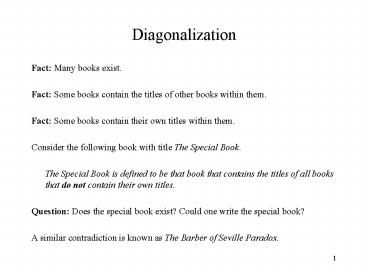Diagonalization - PowerPoint PPT Presentation
1 / 7
Title:
Diagonalization
Description:
The Special Book is defined to be that book that contains the titles of all ... A similar contradiction is known as The Barber of Seville Paradox. 2. Diagonalization ... – PowerPoint PPT presentation
Number of Views:340
Avg rating:3.0/5.0
Title: Diagonalization
1
Diagonalization
- Fact Many books exist.
- Fact Some books contain the titles of other
books within them. - Fact Some books contain their own titles within
them. - Consider the following book with title The
Special Book. - The Special Book is defined to be that book that
contains the titles of all books that do not
contain their own titles. - Question Does the special book exist? Could one
write the special book? - A similar contradiction is known as The Barber of
Seville Paradox.
2
Diagonalization
- Definition
- P(N) is the set of all subsets of N.
- P(N) , 0, 0, 1, 1, 2, 3, 2, 5, 9,
13, - Theorem P(N) is uncountable.
- Proof (by contradiction) Suppose that P(N) is
countable. Then by definition it is either
finite or countably infinite. Clearly, it is not
finite, therefore it must be countably infinite.
By definition, since it is countably infinite it
has the same cardinality as N (the natural
numbers) and, by definition, there is a bijection
from N to P(N).
3
- f N gt P(N)
- 0 gt N0, 1 gt N1, 2 gt N2, f is onto so
every set in P(N) is in this - list.
- Consider the following table
- 0 1 2 3
- N0 d00 d01 d02 d03
- N1 d10 d11 d12 d13
- N2 d20 d21 d22 d23
- dij The table is a 2 dimensional bit vector.
4
- Consider/define the set D such that for each j gt
0 - if and only if ()
- Note that D is represented by the complement of
the diagonal. - Observations
- D is a subset of N
- Since N0, N1, N2, is a list of all the subsets
of N, it follows that D Ni (), for some i gt
0. - Question Is ?
- By definition of D given in , if and
only if - But D Ni by , and substitution gives
if and only if
5
Diagonalization
- Theorem The real numbers are uncountable.
- Proof (by contradiction) Let R denote the set of
all real numbers, and suppose that R is
countable. Then by definition it is either
finite or countably infinite. Clearly, it is not
finite, therefore it must be countably infinite.
By definition, since it is countably infinite it
has the same cardinality as N (the natural
numbers) and, by definition, there is a bijection
from N to R.
6
- f N gt R
- 0 gt r0, 1 gt r1, 2 gt r2, f is onto so
every real number is in this list. - Consider the following table
- 0 1 2 3
- r0 d00 d01 d02 d03
- r1 d10 d11 d12 d13
- r2 d20 d21 d22 d23
- where ri xi.di0 di1 di2 dim (padded with
zeros to the right) - The table is a 2 dimensional vector of digits.
7
- Consider/define the real number
- y 0.y0y1y2(infinite)
- where
- yi (dii 1) mod 10 for all igt0 ()
- Observations
- y is a real number
- Since r0, r1, r2, is a list of all real
numbers, it follows that y must be in this list,
i.e., y rj, for some jgt0. - This means that y rj 0.dj0 dj1 dj2 djj-1
djj djj1 (from the table) - This also means that yi dji, for all igt0, and,
in particular, that - yj djj
- But by
- yj (djj 1) mod 10
- a contradiction. Therefore, no such one-to-one
and onto function exists, and therefore the real
numbers are uncountable.












![❤[PDF]⚡ Greater Than Sudoku Diagonal Puzzles: 200 Easy and Medium Puzzles PowerPoint PPT Presentation](https://s3.amazonaws.com/images.powershow.com/10083348.th0.jpg?_=20240722064)
![READ [PDF] Harry Potter: A Pop-Up Guide to Diagon Alley and Beyond PowerPoint PPT Presentation](https://s3.amazonaws.com/images.powershow.com/10069567.th0.jpg?_=20240702014)

















